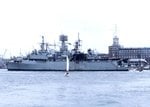CharlesBronson
Senior Master Sergeant
Not sure what "LOL" means. If you are pointing that my post was a joke, well is not a joke I am merely describing a hipotetical situation. The HMS invincible attack story is a good story wich includes 2 good pilots killed (that difinately is no joke), you cant blame the people here for believing in what the surviving pilots said. Most of the narration of the attacks against the Royal navy could be (more or less) being confirmed in british sources, is not the case with the HMS Invincible.CB, you needed an LOL after that post. I know you better.
If you ask me, well some years ago I was sure, but today I have several doubts on it.
Last edited:

